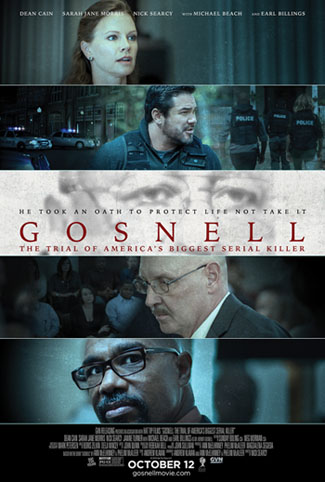It can be said with safety that no other movie completed within the last three years has faced the obstacles of the Gosnell film in finally making it to the “big screen.” Produced by Phelim McAleer and Ann McElhinney and ready for distribution as far back as October 2015, the movie may be a minor cinematic miracle given the film industry’s adamant support for all things abortion. In spite of industry opposition, its creators had the courage to take on this project and persevere in securing a distributor to bring the film to 750 theaters in an October 12 nationwide opening.
The film faced serious opposition from the beginning. Kickstarter refused the producers’ fundraising campaign. In less than two weeks, over two million dollars was raised through the Indiegogo international crowd-funding website. Nonetheless, once the film was completed, no distributor would touch it according to director Nick Searcy in a September 2018 National Review article. He said Hollywood “runs on fear—the fear not only of failure but, more insidiously, of being shunned because of your political opinions.”
Hollywood did not want to publicize the story of Kermit Gosnell, an abortionist operating his clinic in a low-income area of Philadelphia. The 2011 grand jury report described the “house of horrors” facility: “This case is about a doctor who killed babies and endangered women. What we mean is that he regularly and illegally delivered live, viable, babies in the third trimester of pregnancy—and then murdered these newborns by severing their spinal cords with scissors. The medical practice by which he carried out this business was a filthy fraud in which he overdosed his patients with dangerous drugs, spread venereal disease among them with infected instruments, perforated their wombs and bowels—and, on at least two occasions, caused their deaths. Over the years, many people came to know that something was going on here. But no one put a stop to it.”
Orthodox. Faithful. Free.
Sign up to get Crisis articles delivered to your inbox daily
Gosnell dramatizes the February 2010 investigation of Gosnell’s clinic, raided for illegal prescription drug trafficking, the discovery by Detective James Woods, played by Dean Cain, that Gosnell performed abortions beyond the 24-week legal limit, and the center-piece of the movie—the 2013 trial of Gosnell, convicted of three counts of murdering infants born alive and the involuntary manslaughter of 41-year-old Bhutanise refugee Karnamaya Mongar, who suffered a fatal drug overdose during the 2009 abortion of her 19-week-old unborn baby.
Sarah Jane Morris turns in a strong performance as prosecutor Alexis McGuire who’s given the politically charged task of putting an abortionist on trial. Morris strikes a convincing balance as an ambitious legal professional and yet someone emotionally affected by Gosnell’s peculiar brand of abortion slaughter to which she and other characters in the film are exposed.
The most difficult character to perform is that of Kermit Gosnell himself. Actor Earl Billings presents the oblivious-to-reality, self-justifying abortionist in a calm, understated, yet engaging manner. He brings Gosnell’s bizarre personality to life—making it believable that such a person could operate a cat-ridden, vermin-infected, filthy medical office, and be more conscientious about his pet turtles, ironically referred to as an “endangered species,” than about the lives of the unborn and his female patients.
 Gosnell is well-acted, well-written, and well-paced, effectively employing flashbacks to tell its story of the “house of horrors” clinic’s operation. Since it is a movie that scrutinizes the negatives of abortion practice as no other feature film has yet dared to do, and its creators braved pro-abortion hostility to finally bring it to the screen, Gosnell is a cinematic accomplishment, a true film achievement.
Gosnell is well-acted, well-written, and well-paced, effectively employing flashbacks to tell its story of the “house of horrors” clinic’s operation. Since it is a movie that scrutinizes the negatives of abortion practice as no other feature film has yet dared to do, and its creators braved pro-abortion hostility to finally bring it to the screen, Gosnell is a cinematic accomplishment, a true film achievement.
The pro-life movement has thrown its full support behind this movie. Considering the media’s support for “a woman’s right to choose,” the movement has had few opportunities to influence popular culture as to the sordid nature of the abortion industry. Gosnell is thus understandably embraced as a kind of pro-life break-through.
However, while Gosnell clearly does not defend legalized abortion, the film is not ultimately focused on abortion as an injustice per se. The primary focus of Gosnell—is well … Gosnell! At most, it is only secondarily or indirectly about the injustice of abortion. Indeed, if it were not for one very important scene, one could reasonably argue that abortion as the unjust killing of innocent human life is not even indirectly addressed. During Gosnell’s trial his defense attorney, Mike Cohan, played by the film’s director, cross-examines witness-for-the-prosecution abortionist, Dr. North, played by Janine Turner. North is pretty, well-dressed, well-coiffed, and sophisticated—the legitimate abortion practitioner, whose testimony McGuire uses to show just how far Gosnell deviates from sound and accepted medical norms.
North willingly testifies that she has performed over 30,000 abortions, many of them second trimester procedures. But Cohan aggressively pummels her with questions through which, growing progressively uncomfortable, she is forced to reveal the brutality of the late-term dilation and evacuation killing process. She describes how potassium chloride is injected into the heart of 23-week-old fetuses as Cohan presents the hideously long eight-inch needle. North explains that this injection causes fetal demise ensuring babies will not be born alive as was the case in Gosnell’s abortion methods. She is forced to describe the procedure in which the abortionist, guided by sonogram, grabs with forceps an arm or a leg and tears the baby apart, its limbs extracted from the womb. In larger babies the “grey matter” would be suctioned out of the skull and the skull collapsed. No one is spared the grisly details in a dialogue specifically designed to show no difference exists between legal abortion procedures and what Gosnell did in his clinic and for which he stands accused. In terms of getting to the heart of the injustice of abortion itself, this scene was the film’s strongest moment.
Without this scene Gosnell is ultimately the story of a rogue abortionist, which may lead film-goers to conclude that he is not representative of abortion or what happens in abortion clinics. And, of course, since the focus is on late-term abortions, the movie leaves untouched the injustice of what happens in the vast majority of abortions, 90 percent of which take place within 14 weeks of gestation.
This is a thoughtful and professionally crafted movie and, given the cultural context of its release, even a remarkable movie. However, Gosnell stops short from being the unforgettable film that it could have been. The center of this drama is not that, due to the negligence of the Philadelphia Department of Health under orders from then Governor Tom Ridge to not inspect his clinic, Gosnell ran a sub-standard medical practice that placed women at serious risk, even causing their deaths. The real subject of the drama are the babies he murdered, babies he deliberately allowed to be born alive only to kill in a horribly gruesome manner.
The movie focuses on one such victim, namely, Baby A. Upon his live birth and just before Gosnell rendered the death-blow, he exclaimed: “This one’s so big he could walk me to the bus.” The film opens with a staff member named Betty shooting a cell phone picture of something in the clinic, but not until later in the film do we find out she secretly took a picture of this abortion victim. The photo is essential to the movie’s narrative. Even though in the real Gosnell trial no less than 47 photos of abortion victims were projected on a screen for the benefit of the jurors, in the movie it is only the photo of Baby A that drives the narrative forward. The film builds to a climax when Betty, who has refused to disclose the photo or testify against her former boss, responding at last to a pang of conscience, comes to court and the hideous photo is displayed against the wishes of Gosnell’s furious defense attorney.
However, the audience never sees Baby A—and never sees any of Gosnell’s abortion victims, not when they are found by the detectives, not when McGuire sees them in the pathology lab, not in any of the abortion procedure flashbacks—and not even when Baby A’s photo is presented to the jury though everything has been building up to this climatic moment. Only once does the image of an abortion victim appear on screen when during the initial raid on the clinic Detective Woods finds a row of specimen jars. The camera focuses on the bottom of an aborted baby’s foot, a Gosnell abortion “trophy” preserved in formalin solution.
Other than this, the abortion victims remain out-of-sight. The audience only sees the characters’ reactions to the victims, lots of tearful eyes and grimacing expressions. The movie takes the viewer to the edge of reality, and then pulls back. It was obvious that the filmmakers made a prudential decision, but it was one that deprived this film of what would have been that powerful, lasting cinematic impression, the kind of impression that sticks with the viewer days, weeks, maybe even forever—a film that marks viewers as it reveals an unexpected depth of truth they otherwise would never have known.
Not to show the photo of Baby A is an understandable prudential decision. The film’s creators most likely were motivated by marketing concerns. No doubt they wished to expand Gosnell’s accessibility to a wider, popular audience, and needed to guarantee nothing more than a PG-13 rating. We must also consider that the movie had to overcome incredible distribution obstacles, even without graphic imagery! Nonetheless, prudential decisions are one thing and artistic decisions are another and the makers of Gosnell chose the “safer” route in a movie already infused with controversial content. Gosnell is a good film that stopped short of being an unforgettable film.
Not allowing the audience to visually engage with Baby A is somewhat ironic: During Betty’s testimony McGuire asked her why she took the photo. She responded, “Because he was so big. I just thought that there should be a picture of him so people will know he lived a little while.” Yet the people patronizing the Gosnell movie are deprived of viewing the photo that vindicates his life. Concealing this victim is even more odd when one considers that the film shows the horrid image of a dead, decomposing, flea-covered cat rotting in the basement of Gosnell’s house, an irony Eric Scheidler of the Pro-Life Action League insightfully noted. And the makers of Gosnell knew the photo was important to the movie; just before the final credits the audience is directed to view the photo online—after the film is over!
While Gosnell’s abortion practice may be atypical, nonetheless, his clinic is a macrocosm of the abortion industry. As Cheryl Sullenger’s extensive research on abortion clinic illegalities and unethical practices nationwide demonstrates—given the proliferation of free-standing abortion centers since 1973—the majority of clinics contain some element of what characterized Gosnell’s “house of horrors.”
Gosnell does not directly tackle the injustice of abortion. Yet it is the first feature film in wide release that has the potential to cause those sitting on the fence to doubt the legitimacy of abortion. If those conflicted about abortion are honest, they will conclude killing babies in-utero is inherently the same murderous act endured by Baby A and that the despicable nature of abortion leads to a Gosnell house of horrors.
If you are pro-life and do not want the enemies of this film to delight in its becoming a box-office failure, go and see Gosnell before 750 theaters replace it with movies of far less significance.
